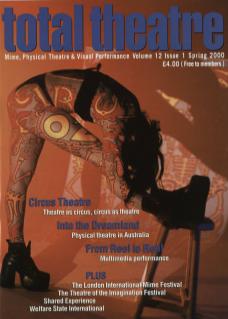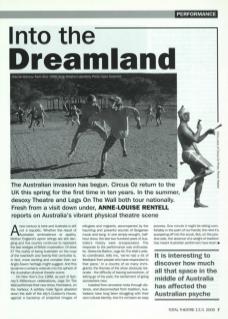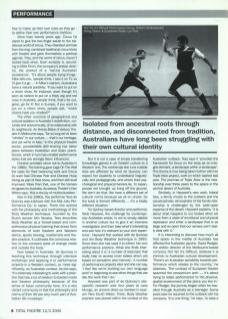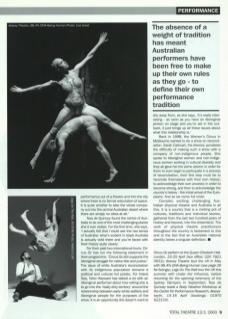A new century is here and Australia is still not a republic. Whether the result of Australian ambivalence or apathy, Mother England's apron strings are still dangling and this country continues to represent the last vestiges of British imperialism. Or does it? The reality of being Australian on the cusp of the twentieth and twenty-first centuries is, in fact, more exciting and complex than our Anglo-Saxon heritage might suggest. And this dynamism certainly extends into the sphere of the Australian physical theatre scene.
On New Year's Eve 1999, as part of Sydney's Millennium celebrations, Legs On The Wall performed their new show, Homeland, on the harbour. A solitary male figure abseiled down the side of the city's Custom's House, against a backdrop of projected images of refugees and migrants, accompanied by the haunting and powerful sounds of Bulgarian music and song. In one simply wrought, half-hour show, the last two hundred years of Australia's history were encapsulated. The response to the performance was enthusiastic. Debra Iris Batton, Legs On The Wall's artistic coordinator, tells me, 'we've had a lot of feedback from people who have responded to that piece'. In a country of so many immigrants, the themes of the show obviously resonate – the difficulty of leaving somewhere, of letting go of the past; the excitement of going somewhere new.
Isolated from ancestral roots through distance, and disconnected from tradition, Australians have long been struggling with their own cultural identity. And it's not been an easy process. One minute it might be sitting comfortably in the palm of our hands; the next it's scarpering off into the scrub. But, on the positive side, the absence of a weight of tradition has meant Australian performers have been free to make up their own rules as they go – to define their own performance tradition.
More than twenty years ago, Circus Oz dared to give the two-finger salute to the traditional world of circus. They liberated animals from the ring, combined traditional circus tricks with theatre, and gave themselves a political agenda. They, and the world of circus, haven't looked back since. Such audacity is, according to Mike Finch, the company's artistic director, the product of a 'natural Australian exuberance'. 'It's about people trying things,’ Mike tells me, 'people think, I saw it on TV, SO I'll give it a go...’ In Mike's opinion, Australians have a natural positivity: 'If you want to put on a clown show, for instance, even though it's seen as radical to put on a frizzy wig and red nose in Australia, people think, that's far out, great, go for it! But in Europe, if you want to put on a clown show, people ask, "which clowns have you studied?"’
The other outcome of geographical and cultural isolation is Australia's redefinition, culturally and economically, of its relationship with its neighbours. As Teresa Blake of desoxy Theatre in Melbourne says, 'for so long we've been "whities" in our culture... that's our heritage, and yet we're in Asia'. In the physical theatre sector, considerable skill-sharing has taken place between Australian and Asian practitioners, which in turn has created performance styles that are strongly Asian-influenced.
Chinese acrobats came out to Australia in the 1980s. The training gave Legs On The Wall the basis for their balancing work and Circus Oz soon had Chinese Pole and Chinese Hoop Diving as part of their show, and their skill level improved. More than that, one of the trainers emigrated to Australia. As desoxy Theatre's Dan Witton says, 'this is the joy of multiculturalism'.
Also in the 1980s, the performer Tess de Quincey was a dancer with the Mai-Juku Performance Co. in Japan. There she worked with the philosophy and methodology of the Body Weather technique, founded by the Butoh dancer Min Tanaka. Tess describes Body Weather as a 'broad-based and comprehensive physical training that draws from elements of both Eastern and Western dance, sports training, martial arts and theatre practice. It cultivates the conscious relation to the constant state of change inside and outside the body.'
Now based in Australia, de Quincey is teaching this technique through intensive workshops and applying it to performance projects in a Western context, or, more significantly, an Australian context. As she says, ‘It's extremely interesting to work with a practice that has a lot of relation to Eastern roots and Eastern philosophy because of the sense of Asian community here. It's a very vibrant community in that the philosophy and norms of their life are very much part of Australian life nowadays.’
But it is not a case of simply transferring knowledge gained in an Eastern culture to a Western one. The workshops she runs outside Asia are affected by what de Quincey can expect her students to understand linguistically and pedagogically, and where their psychological and physical barriers lie. 'In Japan, people are brought up living off the ground. We don't do that. We have a different set of cultural norms because we sit on chairs. So the body is formed differently... It's a totally different situation.'
For Sydney-based director and performer Nikki Heyward, the challenge for contemporary Australian artists 'is not to simply dabble in another culture but to give it an intensive investigation and then take what's interesting and see how it's relevant to your own experience'. Heyward first worked with de Quincey and the Body Weather technique in 1993. Since then she has used it to inform her own performance practice. What she finds interesting about it is 'a number of exercises that really help to access inner states which are based on sensation and memory'. A number of performance projects later and she can say 'I feel like we're building our own language and I'm beginning to see other things that are like the work that I do’.
Heyward was part of de Quincey's site-specific research over four years at Lake Mungo, an ancient dried-up riverbed in western New South Wales. There, Body Weather practice was placed within the context of the Australian outback. Tess says it ‘provided the framework for focus on the body as an integral element, a landscape within a landscape'. This theme is now being taken further with her Triple Alice project, work on which started last year. The premise of Triple Alice is the relationship over three years to the space in the central desert of Australia.
Similarly, in Heyward's new work, Inland Sea, a family moves to the outback and the claustrophobic atmosphere of the family relationship is challenged by the wide-open expanse of the desert. Heyward explains, ‘it is about what happens to our bodies when we move from a state of emotional and physical repression and enter a landscape that is so large and so open that our senses can't really deal with it’.
It is interesting to discover how much all that space in the middle of Australia has affected the Australian psyche
It is interesting to discover how much all that space in the middle of Australia has affected the Australian psyche. David Pledger, the artistic director of the Melbourne-based company Not Yet It's Difficult, believes it is intrinsic to Australian cultural development. ‘There's an Australian sensibility towards performance which relates to the country,’ he observes. ‘The contract of European theatre spawned the proscenium arch... it's about trying to relate performance to the physical, spatial environment of the place you live in.' For Pledger, the journey began when he travelled through Australia as a teenager. Some years later he returned to the outback with his company. ‘It is one thing,’ he says, ‘to take a performance out of a theatre and into the city where there is no formal articulation of space. It is quite another to take the whole company out into the central Australian desert where there are simply no cities at all.’
Tess de Quincey found the centre of Australia to be one of the most challenging places she'd ever visited. ‘For the first time,’ she says, ‘I actually felt that I could see the raw bones of Australia; what's evident in black Australia is actually vivid there and you're faced with their history quite clearly.’
For their past two international tours, Circus Oz has run the following statement in their programme: ‘Circus Oz still supports the Aboriginal struggle for native title and justice’. The issue of white Australia's reconciliation with its indigenous population remains a political and cultural hot potato. For Inland Sea, Nikki Heyward has talked a lot with an Aboriginal performer about how willing she is to go into the ‘really dirty territory' around the relationship between early white settlers and Aboriginal people for the purposes of the show. It is an opportunity she doesn't want to shy away from, as she says, 'it's really interesting – as soon as you have an Aboriginal person on stage and you're set in the outback, it just brings up all these issues about what this relationship is’.
Back in 1998, the Women's Circus in Melboume wanted to do a show on reconciliation. Sarah Cathcart, the director, pondered the difficulty of making such a show with a company of non-indigenous people. She spoke to Aboriginal women and non-indigenous women working in cultural diversity and they all gave her the same advice: in order for them to even begin to participate in a process of reconciliation, their first step must be to reconcile themselves with their own history: to acknowledge their own ancestry in order to become strong, and then to acknowledge the country's history – the initial arrival of the Europeans. And so we come full circle.
Complex, exciting, challenging, Australian physical theatre and Australia is all this. It is a country that is a melting pot of cultures, traditions and individual stories, gathered from the last two hundred years of history and beyond, into the dreamland. The work of physical theatre practitioners throughout the country is testament to this and to the fact that an Australian national identity belies a singular definition.
Circus Oz perform at the Queen Elizabeth Hall, London, 22-25 April; desoxy Theatre tour the UK in May with 98.4% DNA-Being Human; Legs On The Wall tour the UK this summer with Under the Influence, before returning for the opening ceremony of the Sydney Olympics in September; Tess de Quincey leads a Body Weather Workshop at the Centre for Performance Research, Aberystwyth, 15-16 April.



